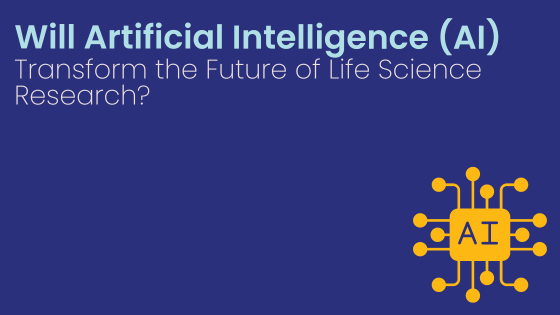Today’s guest blog is written by Ken Doyle, Promega. Reposted from Promega Connections with permission.
Artificial intelligence (AI) is not a new technological development. The idea of intelligent machines has been popular for several centuries. The term “artificial intelligence” was coined by John McCarthy for a workshop at Dartmouth College in 1955 (1), and this workshop is considered the birthplace of AI research. Modern AI owes much of its existence to an earlier paper by Alan Turing (2), in which he proposed the famous Turing Test to determine whether a machine could exhibit intelligent behavior equivalent to—or indistinguishable from—that of a human.
The explosive growth in all things AI over the past few years has evoked strong reactions from the general public. At one end of the spectrum, some people fear AI and refuse to use it—even though they may have unwittingly been using a form of AI in their work for years. At the other extreme, advocates embrace all aspects of AI, regardless of potential ethical implications. Finding a middle ground is not always easy, but it’s the best path forward to take advantage of the improvements in efficiency that AI can bring, while still being cautious about widespread adoption. It’s worth noting that AI is a broad, general term that covers a wide range of technologies.
 Image generated with Adobe Firefly v.2.
Image generated with Adobe Firefly v.2.
For life science researchers, AI has the potential to address many common challenges; a previous post on this blog discussed how AI can help develop a research proposal. AI can help with everyday tasks like literature searches, lab notebook management, and data analysis. It is already making strides on a larger scale in applications for lab automation, drug discovery and personalized medicine (reviewed in 3–5). Significant medical breakthroughs have resulted from AI-powered research, such as the discovery of novel antibiotic classes (6) and assessment of atherosclerotic plaques (7). A few examples of AI-driven tools and platforms covering various aspects of life science research are listed here.
Drug Discovery
MELLODDY (Machine Learning Ledger Orchestration for Drug Discovery) is a project funded by the European Union’s Innovative Medicines Initiative 2 Joint Undertaking. It uses the world’s largest collection of biochemically active small molecules to improve predictive models in drug discovery. The project includes an extended privacy management system to address concerns about intellectual property for the pharmaceutical companies who are contributing data to machine learning (ML) models.
Insilico Medicine provides end-to-end, generative AI-driven solutions to accelerate drug discovery and development. Its Pharma.AI platform focuses on disease target identification, generation of novel molecule data and predicting clinical trial outcomes.
NVIDIA Clara™ for Biopharma: NVIDIA, best known for computer graphics cards, is now at the center of the AI revolution, with an ambitious goal to bring AI to every industry. Its Clara™ suite brings together computing platforms, software and services with a focus on life sciences and healthcare. Highlights include BioNeMo (large language model [LLM] training for foundation models in drug discovery), AutoDock (structure-based small-molecule virtual screening), RELION (machine learning methods for cryo-electron microscopic analysis of macromolecules), and GROMACS (a simulator for complex interactions among biologically relevant molecules).
Other organizations dominating the AI space in drug discovery include Genentech (Roche) in collaboration with NVIDIA, and the Eric and Wendy Schmidt Center at the Broad Institute.
 Image generated with Adobe Firefly v.2.
Image generated with Adobe Firefly v.2.
Laboratory Workflows
Autoprotocol is an offering from Strateos, an AI-driven remote access, automated laboratory company for the life sciences that offers cloud-based laboratory control software services. Autoprotocol is an open-source project that provides a precise way of describing common laboratory protocols, so that they can be used in automated laboratory runs. Examples include liquid handling, Illumina sequencing, Sanger sequencing, oligosynthesis, and more.
Benchling, a popular cloud-based service for researchers to plan, manage, analyze data and collaborate on experiments, is building AI into its services. The program is still in beta, with a few data analysis modules currently available.
Bioinformatics and Data Analysis
DNAscope from Sentieon now incorporates AI to further improve the accuracy of its variant-calling software for next-generation sequencing (NGS). It offers improved active region detection, more powerful local assembly of reads, and incorporation of pretrained ML models for both short reads (Illumina) and long reads (PacBio and Oxford Nanopore). Sentieon develops and supplies bioinformatics software to process NGS data with higher computing efficiency and accuracy than many comparable solutions.
DRAGEN from Illumina now uses an enhanced ML model to increase its variant-calling accuracy for NGS data. It provides a single platform for analysis of whole genome, exome, methylome and transcriptome sequence data.
tinybio is an LLM for biological research that includes an AI chat agent to help bioinformaticians analyze data, an experiment generator to determine what types of analyses are possible for a set of samples, and a pipeline generator to speed up building NGS data analysis pipelines.
DeepChem is an open-source framework for drug discovery, built around a Python library for ML and deep learning (DL). It was developed by a collaboration between Stanford University and Deep Forest Sciences. Although the primary focus within life science applications is drug discovery, the DeepChem project supports a range of applications, including bioinformatics.
Literature Research
Although these resources were not built specifically for life science research, they go beyond simply retrieving literature references on specific topics.
scite is a service for discovering and evaluating scientific articles (Nicholson, 2021), built around “Smart Citations”. Smart Citations allow users to see where a publication has been cited by providing the context of the citation and a classification describing whether it provides supporting or contrasting evidence for the cited claim. Users can ask simple, natural-language questions and get comprehensive answers from over a million research publications. scite offers a Chrome browser extension for added convenience.
Elicit is similar to scite in that it responds to natural-language questions with a list of literature references, along with a summary of the key points. Elicit claims that it’s well suited for automating systematic reviews and meta-analyses of published studies. It also lets you upload your own PDFs of research papers and will summarize the results.
SciSpace offers similar features to both Elicit and scite. While other tools are primarily focused on English-language publications, SciSpace uses its own literature database that includes research published in over 75 languages.
Consensus is built both for scientific researchers and consumers. It answers natural-language questions with a clear, comprehensible summary of relevant research publications, along with a score showing how many studies agree or disagree with the consensus conclusions from the studies.
 Image generated with Adobe Firefly v.2.
Image generated with Adobe Firefly v.2.
Challenges and Opportunities
The biggest challenges facing the adoption of AI-driven tools include ethical use of information (especially in training LLMs), accuracy of the datasets on which the tools are based and concerns about job displacement. In the consumer space, intellectual property concerns have resulted in multiple legal challenges to OpenAI and Meta—most notably, suits filed by prominent fiction authors. Clearly, more work is needed to address how AI developers use copyrighted information. Data accuracy issues should improve with increased efforts to ensure that foundational datasets are representative and unbiased, especially for AI tools used in healthcare.
As for job displacement, many organizations are studying the impact of AI on a variety of roles within the workplace. Within the life sciences, the potential impact of AI adoption is wide-ranging, but there’s reason to be cautiously optimistic. An interview with Dr. Oliver Stegle, group leader in the Genome Biology Unit at EMBL, provides a foundation for this optimism.
In conclusion, AI is already transforming life science research. From improving data analytics to accelerating drug discovery to increasing the efficiency of basic laboratory workflows, AI offers unprecedented opportunities for researchers to change the way they work. Ongoing conversations around ethical AI use, data accuracy and intellectual property will help ensure that AI-driven improvements create a brighter and more collaborative future for life science researchers.
Note: This blog post (except for the sidebar) was written entirely by a human, who—despite occasional questions about his humanity or lack thereof—acknowledges there are some things AI still can’t do…yet.
References
- McCarthy, J. et al. (2006) A proposal for the Dartmouth summer research project on artificial intelligence, August 31, 1955. AI Magazine 27(4), 12–14.
- Turing, A.M. (1950) Computing machinery and intelligence. Mind LIX(236), 433–460.
- Blanco-González, A. et al. (2023) The role of AI in drug discovery: challenges, opportunities, and strategies. Pharmaceuticals 16, 891.
- Mock, M. et al. (2023) AI can help to speed up drug discovery—but only if we give it the right data. Nature 621, 467–470.
- Wang, H. et al (2023) Scientific discovery in the age of artificial intelligence. Nature 620, 47–60.
- Wong, F. et al. (2024) Discovery of a structural class of antibiotics with explainable deep learning. Nature 626, 177–185.
- Föllmer, B. et al. (2024) Roadmap on the use of artificial intelligence for imaging of vulnerable atherosclerotic plaque in coronary arteries. Nat. Rev. Cardiol. 21, 51–64.
WOULD YOU LIKE TO SEE MORE ARTICLES LIKE THIS? SUBSCRIBE TO THE ISHI BLOG BELOW!
SUBSCRIBE NOW!


